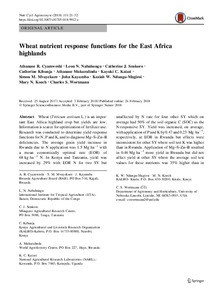| dc.contributor.author | Cyamweshi, A.R. |
| dc.contributor.author | Nabahungu, L.N. |
| dc.contributor.author | Senkoro, C.J. |
| dc.contributor.author | Kibunja, C.N. |
| dc.contributor.author | Mukuralinda, A. |
| dc.contributor.author | Kaizzi, K.C. |
| dc.contributor.author | Mvuyekure, S.M. |
| dc.contributor.author | Kayumba, J. |
| dc.contributor.author | Ndungu-Magiroi, K.W. |
| dc.contributor.author | Koech, M.N. |
| dc.contributor.author | Wortmann, C.S. |
| dc.date.accessioned | 2019-12-04T11:23:42Z |
| dc.date.available | 2019-12-04T11:23:42Z |
| dc.date.issued | 2018-05 |
| dc.identifier.citation | Cyamweshi, A.R., Nabahungu, L.N., Senkoro, C.J., Kibunja, C., Mukuralinda, A., Kaizzi, K.C., ... & Wortmann, C.S. (2018). Wheat nutrient response functions for the east Africa highlands. Nutrient Cycling in Agroecosystems, 111(1), 21-32. |
| dc.identifier.issn | 1385-1314 |
| dc.identifier.uri | https://hdl.handle.net/20.500.12478/4115 |
| dc.description | Published online: 24 Feb 2018 |
| dc.description.abstract | Wheat (Triticum æstivum L.) is an important East Africa highland crop but yields are low. Information is scarce for optimization of fertilizer use. Research was conducted to determine yield response functions for N, P and K, and to diagnose Mg–S–Zn–B deficiencies. The average grain yield increase in Rwanda due to N application was 1.5 Mg ha−1 with a mean economically optimal rate (EOR) of 68 kg ha−1 N. In Kenya and Tanzania, yield was increased by 29% with EOR N for two SY but unaffected by N rate for four other SY which on average had 50% of the soil organic C (SOC) as the N-responsive SY. Yield was increased, on average, with application of P and K by 0.47 and 0.23 Mg ha−1, respectively, at EOR in Rwanda but effects were inconsistent for other SY where soil test K was higher than in Rwanda. Application of Mg–S–Zn–B resulted in 0.46 Mg ha−1 more yield in Rwanda but did not affect yield at other SY where the average soil test values for these nutrients was 35% higher than in Rwanda. If the financially constrained farmer opts to apply the affordable fertilizer to twice as much land at 50% EOR compared with 100% EOR, the mean yield increase is reduced by 27% but production and PCR are increased by 43 and 72%, respectively. Nutrient effects were relatively consistent and positive in Rwanda, but less and less inconsistent elsewhere with generally less SOC, more K–Mg–S–Zn–B availability, and often lower yields. |
| dc.description.sponsorship | Alliance for a Green Revolution in Africa |
| dc.format.extent | 21-32 |
| dc.language.iso | en |
| dc.subject | Highlands |
| dc.subject | Fertilizers |
| dc.subject | Application |
| dc.subject | Triticum Aestivum |
| dc.subject | Wheat |
| dc.subject | Nutrient |
| dc.title | Wheat nutrient response functions for the east Africa highlands |
| dc.type | Journal Article |
| dc.description.version | Peer Review |
| cg.contributor.crp | Roots, Tubers and Bananas |
| cg.contributor.affiliation | Rwanda Agriculture Board |
| cg.contributor.affiliation | International Institute of Tropical Agriculture |
| cg.contributor.affiliation | Mlingano Agricultural Research Centre |
| cg.contributor.affiliation | Kenya Agricultural and Livestock Research Organization |
| cg.contributor.affiliation | World Agroforestry Centre |
| cg.contributor.affiliation | National Agricultural Research Organisation, Uganda |
| cg.coverage.region | Africa |
| cg.coverage.region | East Africa |
| cg.coverage.country | Kenya |
| cg.coverage.country | Rwanda |
| cg.coverage.country | Tanzania |
| cg.creator.identifier | Nsharwasi Nabahungu: 0000-0002-2104-3777 |
| cg.researchtheme | NATURAL RESOURCE MANAGEMENT |
| cg.isijournal | ISI Journal |
| cg.authorship.types | CGIAR and developing country institute |
| cg.iitasubject | Natural Resource Management |
| cg.journal | Nutrient Cycling in Agroecosystems |
| cg.howpublished | Formally Published |
| cg.accessibilitystatus | Limited Access |
| local.dspaceid | 99590 |
| cg.targetaudience | Scientists |
| cg.identifier.doi | https://dx.doi.org/10.1007/s10705-018-9912-z |

